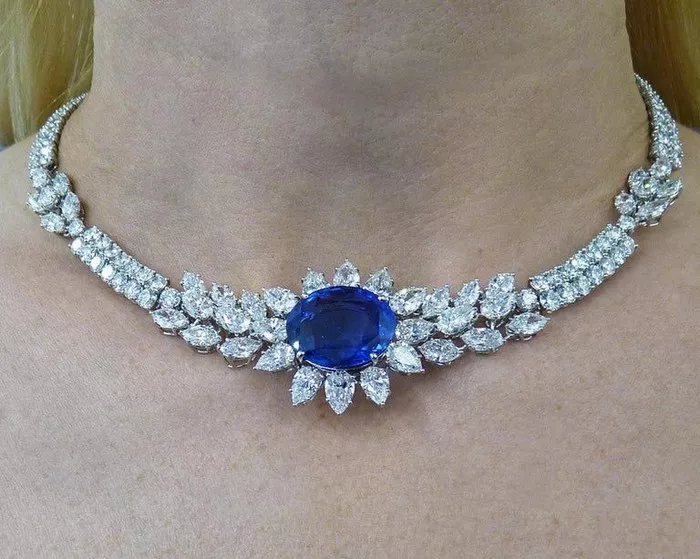In the realm of precious gemstones, two standouts reign supreme: the illustrious diamond and the resplendent sapphire. Their allure has captivated humanity for centuries, adorning crowns, engagement rings, and ceremonial artifacts with unmatched brilliance. Yet, when it comes to determining which holds greater worth, a nuanced exploration is necessary. Let us delve into the multifaceted facets of composition, brilliance, fire, origin, and historical significance to discern the intrinsic value between diamond and sapphire.
Composition:
Diamond:
At the heart of every diamond lies a simple yet mesmerizing truth—it is composed solely of carbon atoms arranged in a crystalline lattice structure. This elemental purity imbues diamonds with a timeless elegance and durability that withstands the test of time.
Sapphire:
In contrast, sapphires belong to the corundum family, characterized by their crystalline formation of aluminum oxide. While impurities within the crystal lattice impart a spectrum of vibrant hues, the core composition remains rooted in aluminum and oxygen atoms. This chemical makeup grants sapphires their diverse color palette, ranging from deep blues to fiery reds.
Brilliance & Fire:
Diamonds:
One of the most captivating qualities of diamonds lies in their unparalleled brilliance and fire. With a refractive index of 2.42, diamonds possess a remarkable ability to bend and reflect light, resulting in a dazzling display of spectral colors. The interplay between facets within the diamond crystal enhances its luminosity, creating an enchanting dance of light that mesmerizes the beholder.
Sapphires:
While sapphires possess a commendable refractive index ranging between 1.76 – 1.77, their brilliance and fire pale in comparison to their diamond counterparts. The lower refractive index limits the intensity of light dispersion within the sapphire crystal, resulting in a subtler play of color and luster. Nonetheless, sapphires exhibit a unique charm, exuding a velvety sheen that emanates sophistication and allure.
Origin & History:
Diamonds:
The saga of diamonds traces back over 900 million years to the depths of the Earth’s mantle, where immense pressure and heat forge these coveted gemstones. Historically, diamonds first emerged in the alluvial deposits of India, where they adorned the regalia of ancient monarchs and symbolized opulence and power. The allure of diamonds transcended continents, captivating civilizations from the Indus Valley to the Roman Empire, where they were prized as talismans of strength and invincibility.
Sapphires:
In the annals of history, sapphires occupy a storied place, revered for their celestial beauty and symbolic significance. From the ancient empires of Greece and Rome to the opulent courts of medieval Europe, sapphires have adorned the crowns of kings and the necks of empresses. Beyond their ornamental allure, sapphires have been imbued with profound meaning, representing virtues of fidelity, nobility, and sincerity across cultures and epochs.
Cultural Significance:
Diamonds:
In modern times, diamonds have ascended to the zenith of cultural symbolism, epitomizing enduring love, commitment, and prosperity. The tradition of exchanging diamond engagement rings dates back to the 15th century, popularized by European aristocracy and immortalized by iconic brands like De Beers. Today, diamonds continue to serve as cherished heirlooms, celebrating life’s most cherished milestones with timeless elegance and sentiment.
Sapphires:
Equally steeped in cultural lore, sapphires evoke a sense of mystique and romance that transcends generations. From the legendary sapphire engagement ring of Princess Diana to the sapphire-encrusted coronation crown of Queen Elizabeth II, these azure gemstones embody regal splendor and timeless allure. Beyond their association with royalty, sapphires have found resonance in diverse cultures, symbolizing truth, wisdom, and spiritual enlightenment.
Market Value:
Diamonds:
The diamond market stands as a paragon of stability and prestige, fueled by robust demand from discerning consumers worldwide. The rarity and enduring appeal of diamonds command premium prices, with factors such as carat weight, cut, color, and clarity dictating their market value. As a tangible store of wealth and status symbol, diamonds continue to exert a gravitational pull on investors and collectors alike, underpinning their enduring allure and economic resilience.
Sapphires:
In the realm of colored gemstones, sapphires occupy a coveted niche, prized for their beauty, rarity, and investment potential. The market for fine sapphires spans a spectrum of hues, from velvety blue Kashmir sapphires to vibrant pink Padparadscha sapphires, each commanding premium prices commensurate with their quality and provenance. While diamonds may reign supreme in terms of market liquidity and global recognition, sapphires offer investors a distinctive alternative, characterized by their intrinsic beauty and enduring appeal.
Conclusion:
In the eternal debate between diamond and sapphire, the answer to which holds greater value is as multifaceted as the gemstones themselves. While diamonds dazzle with their unrivaled brilliance and timeless allure, sapphires captivate with their celestial beauty and rich symbolism. Whether adorned as a symbol of enduring love or cherished as a rare investment asset, both gemstones occupy a cherished place in the pantheon of human culture and heritage. Ultimately, the value of a gemstone transcends its monetary worth, resonating with the emotions, aspirations, and timeless beauty that endure across generations.
As we continue to navigate the kaleidoscope of human experience, let us embrace the intrinsic value of these precious gemstones, each a radiant testament to the enduring allure of nature’s creations.

